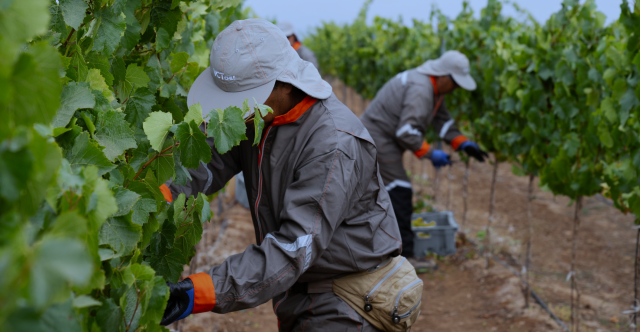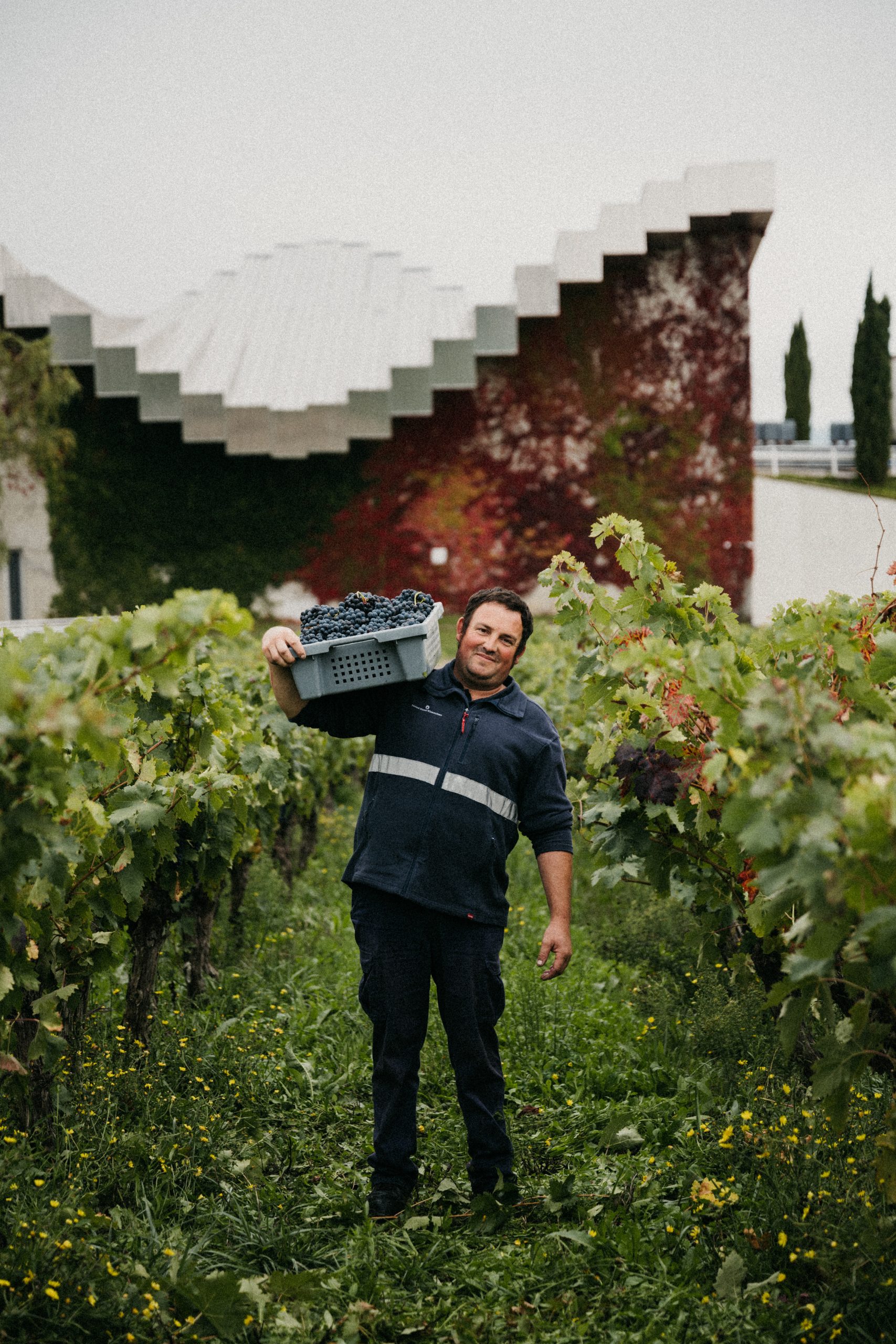Chile’s contrasting 2024 harvest declared ‘excellent’ by country’s biggest producer
After a growing season of marked climatic contrasts, Chile’s largest wine producer, Concha y Toro, has declared the 2024 vintage as “excellent”, before providing a rundown on the quality of grapes in each region.

As previously reported by db, this year’s harvest has been unusually long in Chile, spanning as many as four months, due to opposing conditions in the far north of the country, compared to the central and southern zones of this long landmass.
Indeed, as we noted last month, quoting Eduardo Jordan, who makes wines along the breadth of the country for Miguel Torres Chile, “This was one of the longest harvests I have known – we started harvesting on 2 February in Limarí, and were picking up until 9 May with Carmenère in Maule.”
Such an extended period of picking was due to the very different weather across the country, with heat and drought characterising the northern vineyards of Limarí and Elqui, bringing forward harvesting by as much as three weeks, while cooler conditions further south, as well as an abundance of winter rains, delayed picking by almost the same amount.
Overall, commentators for Concha y Toro called the 2024 harvest “excellent”, noting that “yields were in line with expectations, and grape quality “outstanding”.
Nevertheless, the major producer added that the 2023-2024 growing period “was quite unique”, marked by a particularly rainy winter, which was one of the wettest of the past 30 years (with more than 600 millimetres in the central zone). Importantly, this high-level of winter-time precipitation allowed the soils to be cleansed of salts, while replenishing water levels.
Marcelo Papa, technical director of Concha y Toro and chief winemaker for Amelia and Marques de Casa Concha Heritage wines, recorded the reasons for delays in vine development in all areas of the country, except for the far north.
He noted that the influence of El Niño led to a generally cool spring, with more cloudiness and therefore lower temperatures, as well as higher soil moisture due to the winter rains.
As a result, he said, “We finished veraison two weeks later than in a normal year; however, once this stage was over, the temperatures during ripening were very favourable, thus recovering a week, reaching the harvest with only a one-week delay.”
However, as noted above, conditions were considerably different for the northern vineyards.
Highlighting the extreme difference, he said that the central zone experienced “a cycle of great freshness” with plenty of rain and high yields, while the Limarí Valley was subjected to a warmer season, with little in the way of winter rains and lower-than-usual yields – leading to an advance in the harvest date by about ten days for Concha y Toro’s vineyards.
Overall, Papa said, “We are very happy with the quality of the 2024 harvest, which was a cool year with abundant winter rains, resulting in wines of attractive colour, rich fruit expression, great balance, a lower alcohol level than in previous years, and balanced natural acidity.” Summing up, he said, “This harvest will result in wines with an elegance and quality of tannins comparable only to the best vintages in history.”
Read more
Chile’s 2024 harvest long but outstanding
El Niño and La Niña
Chile is a country climatically influenced by the presence or absence of the El Niño and La Niña phenomena. After being influenced by La Niña between 2018 and 2023 – which led to slightly cooler-than-usual sea surface temperatures, less rainfall, and lower temperatures and thermal accumulation in Chile’s interior – El Niño began to reverse the trend at the beginning of 2023. As Marcelo Papa explained, this translates to a slight increase in sea surface temperatures, more cloud cover and water condensation, higher rainfall, and warmer temperatures inland.
Limarí Valley
The 2023-2024 season was challenging in the Limarí Valley, with average temperatures higher than in the past six years – accumulating 1,516 Degree Days (DD Base 10) at Quebrada Seca from August to February – and scarce winter rainfall, recording just 39 mm of rain during the winter months, significantly lower than the 118 mm historical average for the area.
As a result, the harvest was brought forward by about ten days compared to the average in the region, with picking beginning for Chardonnay and Pinot Noir on 31 January and 1 February respectively, and extended until 15 February.
Partner Content
Papa said: “We expect crisp Chardonnay wines, with good concentration, marked salinity, and characteristic minerality. The Pinot Noirs, in turn, will also have good concentration, slightly more restless tannins than usual due to the early harvest, along with good fruit expression and mineral character. Somewhat salty and savoury on the palate.”y
Casablanca Valley
As in much of the central and southern regions of the country, this season in the Casablanca Valley was characterised by good water availability during winter, which favoured adequate bud break. However, as spring was cooler, flowering extended beyond the usual period, resulting in uneven fruit set and some millerandage in certain areas. Similarly, veraison was delayed by ten days, only beginning in mid-February and continuing due to the cooler weather throughout the month. March saw an early onset of autumn, with lower minimum temperatures and cloudier mornings than usual, although daytime temperatures were higher, allowing ripening to progress.
Lorena Mora, chief winemaker of Terrunyo Sauvignon Blanc, recorded “a significant delay in grape ripening, leading to a harvest with lower sugar accumulation, reduced alcohol concentration, and the latest harvest in the past 14 years, with this year’s harvest taking place on the 3rd and 5th of April.”
Noting that the harvest was three years later than normal, he added, “In the more than ten years I’ve been making wine from this vineyard for Terrunyo, we’ve never harvested in April before.”
Commenting on the wine quality, he said, “This year will result in highly expressive wines with a great variety of aromas and flavours – a hallmark of the Los Boldos vineyard – with mineral, floral, fruity, and herbal notes. On the palate, the wines will be balanced, with well- balanced acidity, good volume, freshness, and density.”
Maipo Valley
Like the rest of the central-southern valleys of the country, the 2023-2024 season in the Maipo Valley began with a rainy winter, reaching 438 mm in Puente Alto and 379 mm in Pirque, significantly higher than the 178 mm and 216 mm recorded in Puente Alto and Pirque, respectively, the previous year.
In both the Pirque Viejo vineyard and the El Mariscal vineyard in the D.O. Maipo Andes, the vines started strongly in spring, achieving good shoot development. As for the véraison, it began on a date in line with a normal year; however, due to the colder spring, this stage in the vine’s development was prolonged, finishing two weeks later than expected. Nevertheless, during January and February, the valley experienced very favourable temperatures—neither too low nor excessively high—which allowed the maturity of the grapes to recover by a week, thus avoiding a more prolonged harvest delay.
Regarding thermal accumulation in these vineyards, this year was indeed cooler, recording 1,722 DD (from September to the end of March), compared to the average of 1,810 DD over the past ten years.
Overall, in the Maipo Valley, the harvest date was delayed by one week to ten days. In the Pirque Viejo vineyard, the harvest took place on 5 April, while in the El Mariscal vineyard, harvesting began with the cutting of some parcels on 27 March, but generally on 1 April, extending until 17 April. In the Maipo Andes area—sectors of Pirque and Puente Alto—the last day of harvest was 24 April.
Marcelo Papa, chief winemaker of Marques de Casa Concha Heritage, said, “The 2024 wines show a very interesting balance of alcohol and acidity. They will not be extremely concentrated or powerful wines, but rather very juicy, with abundant fresh fruit, excellent quality tannins, and great elegance—similar to the 2021 vintage. I am very pleased; I believe this is a very attractive harvest.”
Cachapoal Valley
At the Peumo vineyard, where all the top-end Carmenere wines of Concha y Toro originate, the 2024 harvest was generally very good, with yields in line with expectations, and excellent health and quality of the grapes. The 2023-2024 season was also characterised by higher rainfall than the average year, with 623 mm of water compared to only 242 mm in the previous season. This resulted in the plants exhibiting much more vigour and vegetative expression than in previous periods. “The abundant winter rains necessitated greater leaf removal, shoot pruning, and less irrigation during this season,” recorded Domingo Marchi, agricultural manager of the Cachapoal Valley.
In terms of temperatures, it was a rather cool season, with a cold and overcast spring, which led to a delayed fruit set. December and the first half of January were also less warm than usual, with cool nights, resulting in a prolonged growing period. However, the warmer days during ripening and a greater temperature range between day and night helped achieve outstanding grape quality.
“Due to having a cold spring and a long autumn, we had to be very attentive to the vineyard and the season, undertaking careful agricultural work. The result was exceptional grape quality, remaining very healthy until the last moment they hung on the vine. I am sure this will be one of the best years for Carmenere from Concha y Toro,” said Domingo.
The thermal accumulation was 1,997 DD (from September to the end of April). This coolness during the season and the abundant winter rains explain the ten-day delay in grape maturity. As a result, the harvest at Peumo only began on 10 May and continued until 15 May, when the grapes for Carmín de Peumo were harvested.
“This season, the Carmenere wines are expected to be very juicy and have a rich acidity due to the long growing period. Furthermore, they are wines with a rather moderate alcohol level, around 13.5°, with very soft, elegant tannins, and a deep, attractive colour,” according to Marcio Ramirez, chief winemaker at the Cachapoal Valley cellar, and for the Carmín de Peumo and Terrunyo Carmenere wines.
Related news
Castel Group leadership coup escalates
For the twelfth day of Christmas...
Zuccardi Valle de Uco: textured, unique and revolutionary wines




